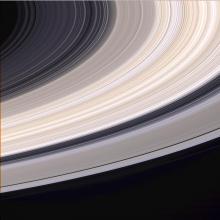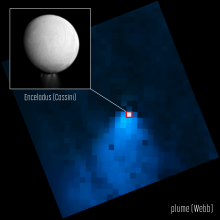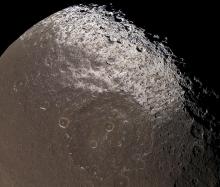You are here
Saturn

Like its larger sibling, Jupiter, Saturn is a ball of hydrogen and helium gas wrapped around a heavy core. Instead of an abrupt boundary between them, the core and the surrounding layers probably flow together.
Saturn spins so fast that it bulges outward at the equator, so the planet is much thicker at the equator than through the poles.
Saturn's rapid rotation and its layered structure produce a magnetic field. Observations by the Cassini spacecraft suggest that the field may be changing, which could mean that Saturn's interior is changing as well. Cassini monitored radio waves produced by the magnetic field as a way to measure Saturn's rotation rate. (Because Saturn has no solid surface, it's impossible to measure its rotation by tracking surface features like mountains or canyons.) But the craft found that the rotation rate appeared to have slowed by about six minutes since the Voyager missions two decades earlier. Scientists believe that Saturn is not actually slowing down. Instead, one possible explanation says that changes in the planet's core are creating changes in the magnetic field.
Saturn's clouds contain ammonia, methane, and other toxic compounds. They are buffeted by winds of up to 1,000 miles (1,600 km) per hour, and they contain violent storm systems that produce lightning blasts a thousand times more powerful than those on Earth.
Saturn's most prominent feature, though, is its extensive ring system.
Galileo Galilei discovered the rings in the early 17th century. In his small, crude telescope, though, they looked like "bumps" on the sides of the planet. Five decades later, Dutch astronomer Christaan Huygens, who had recently discovered Saturn's largest moon, Titan, detected a bit of space between Saturn and the bumps. He deduced that the bumps were really planet-circling rings.
Today, astronomers know that thousands of individual rings make up Saturn's ring system. Most of the rings are made of small bits of ice, others contain tiny grains of dust, and still others are a mixture of the two. In all, the rings are no more than a few hundred feet thick. Several small moons orbit inside or just outside the ring system. These "shepherd" satellites help keep the ring particles in place, but they also sculpt some rings into odd shapes, with twists and kinks.
Saturn's rings probably formed when a small moon or a comet passed close to Saturn and was pulled apart by the planet's gravity.
French mathematician Edward Roche first described this process around 1850. A planet's gravity pulls more strongly on the side of a moon that is facing it than on the side that is away from it. If a moon passes too close to its parent planet, this difference, called tidal gravity, pulls it apart, turning the moon into cosmic rubble. Over time, the rubble spreads out to form rings -- like those that encircle Saturn.
There is disagreement, though, on when that happened. Some studies say the rings formed billions of years ago, perhaps at the same time as Saturn itself. Others, however, say they formed more recently -- perhaps within the last hundred million years.
Although Saturn has no solid surface to stand on, humans may someday view its rings from close range. They may walk on some of its icy moons or even float above Saturn's clouds in big balloons. From such a lofty vantage point, the rings would form wide, sparkling bands across the sky. Sometimes, icy particles from the inner edge of Saturn's rings may fall into the planet's atmosphere, creating bright "shooting stars" as they streak through the sky of this delicate giant.
Last Update: June 2, 2021
Viewing Guide
♄ Saturn appears yellowish-white and is only of moderate brightness, and the famous rings are visible only in a telescope this year. Saturn begins 2023 in constellation Capricornus, then moves over into Aquarius where it remains until 2024.
Exploration
Four spacecraft have explored Saturn. The first was Pioneer 11, in 1979. The most recent, Cassini, entered orbit around Saturn in the summer of 2004 and transmitted tens of thousands of images of the planet and its rings and moons. On January 14, 2005, a second part of the mission, the Huygens probe, parachuted to a soft landing on Titan. Its images showed a landscape carved by flowing liquid. Cassini's instruments have peered through Titan's atmospheric haze to discover possible pools of liquid and a possible volcano on Titan's surface. Cassini ended its reconnaissance of the Saturn system on September 15, 2017, when it plunged into Saturn. Engineers destroyed the craft to eliminate the risk of it hitting one of Saturn's moons, perhaps contaminating it with terrestrial microbes.
At a Glance
| Discovery |
| Known since antiquity |
| Name |
| Roman god of agriculture |
| Average Distance from Sun |
| 885,904,700 miles 1,426,725,400 km 9.5 Astronomical Units |
| Mass |
| 95 times Earth's mass |
| Equatorial Diameter |
| 74,898 miles 120,536 km |
| Length of Day |
| 10 hours, 39 minutes |
| Length of Year |
| 29.4 Earth years |
| Surface Gravity |
| 0.74 that of Earth (If you weigh 100 pounds, you would weigh about 74 pounds on Saturn) |
| Known Moons |
| 82 as of June 2021 Titan, Enceladus, Iapetus, Mimas |
Teacher Copies
Request a free copy of The Solar System or Beyond the Solar System for your classroom. Bulk copies are available for $1.50 each in quantities of 30 or more. Shipping is included. Call 512-471-5285 for orders of 30 or more.
 The Astro Guides for the Solar System and Beyond the Solar System are supported by the National Aeronautics and Space Administration under Grant Nos. NNG04G131G and NAG5-13147, respectively.
The Astro Guides for the Solar System and Beyond the Solar System are supported by the National Aeronautics and Space Administration under Grant Nos. NNG04G131G and NAG5-13147, respectively.






